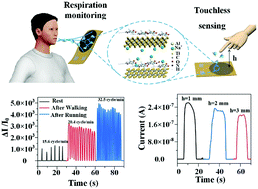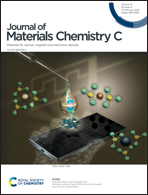A high-performance humidity sensor based on alkalized MXenes and poly(dopamine) for touchless sensing and respiration monitoring†
Abstract
The typical mode of interaction between humans and machines in current intelligent equipment and personalized health care systems is mainly contact-type. However, there are severe problems associated with direct contact, such as uncomfortable wear and cross-infection of bacteria or viruses, especially under global pandemic conditions (e.g., COVID-19, MERS-CoV). In this study, a flexible humidity sensor is developed based on alkalized MXenes and polydopamine (PDA). The unique accordion-like hierarchical structure of the alkalized MXenes with large specific surface area and the chemical structure of the abundant water-absorbing functional groups of PDA wrapped on the MXene surface contribute synergistically to the outstanding performance of the sensor, which has high sensitivity, rapid response, and large detection range. The device was successfully used to control a noncontact switch system based on the distance of the fingertip and monitor different breathing patterns of a volunteer from a long range, proving its potential application in future noncontact human-machine interaction and human physiology monitoring.



 Please wait while we load your content...
Please wait while we load your content...